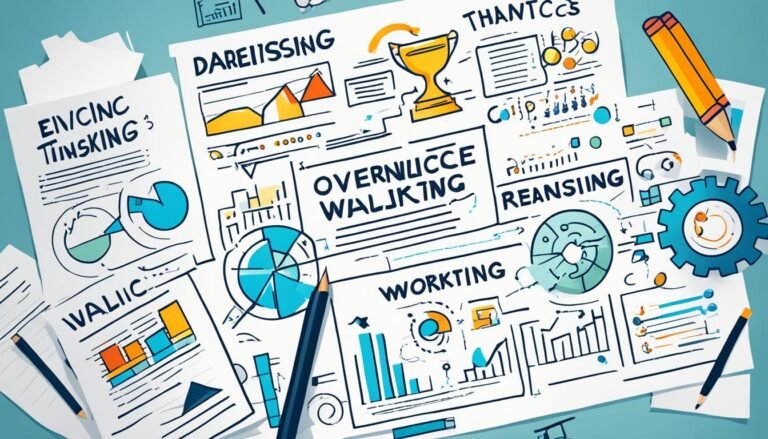The Psychological Barriers to Creative Thinking and How to Overcome Them
Welcome to our article on how psychological barriers can stop creative thinking and how to get past them. Creative thinking lets us think in new ways, come up with fresh ideas, and solve problems uniquely. But, certain barriers in our minds can slow us down and keep us from being as creative as we can be.
We’ll look at some common barriers to creative thinking in this article and how to beat them. Knowing and dealing with these barriers helps increase creativity and solves problems better. It also helps open up new ways to innovate.
Our journey will cover issues like having unclear goals, being scared of failure or rejection, avoiding change, being passive, and justifying our actions. These are big mental obstacles. But, by learning how they affect us, we can develop strategies to overcome them.
Key Takeaways:
- Recognize the psychological barriers that hinder creative thinking.
- Overcome the fear of failure and rejection to unleash your creativity.
- Embrace change and step out of your comfort zone.
- Avoid passivity and seek continuous learning and stimulation.
- Challenge rationalization and strive for improvement.
Lack Of Direction From Yourself or Others
Not knowing your goals can block creative thinking. It’s key to have clear goals and plans written down. This helps you focus on solving problems by sparking your creativity.
Clear goals lead you towards a goal. They make it easier to find new ideas and solutions. You know where to aim your creative efforts when you have a target.
It’s as vital to have written plans of action. Writing your thoughts down brings order and clarity. This helps you know what steps to take. It acts as a guide, keeping you on the right track.
Clear goals and plans boost both problem-solving skills and creative thinking. They form the base for new ideas to grow. With these tools, you can beat the confusion that often comes with the creative process.
Being Afraid of Failure
The fear of failing can stop people from solving issues effectively. It makes them worry about making a wrong move. This worry keeps them from thinking creatively and trying new ways to solve problems.
“The only real failure is the failure to try. Everything else is just a stepping stone on the path to success.”
When someone is scared to fail, they avoid risks and staying safe. But this leads to doing nothing new. It stops progress and limits how well they can solve problems.
Failure is part of learning. The fear comes from thinking the worst will happen. Changing the way we look at failure can help. Seeing it as a chance to learn leads to overcoming this fear. And it helps unlock our creativity.
Instead of being stuck by the fear of failing, we should learn from mistakes. This way, we feel free to try new things without worry about the bad outcome.
Anticipation of Failure and Ineffective Problem Solving
Anticipating failure is bad for problem-solving. It makes us focus on what might go wrong. This stops us from coming up with new and creative ideas. And it makes solving problems harder than it should be.
Thinking about failing too much makes it hard to see clearly. It stops us from bringing fresh ideas to the table. This leads to picking what’s safe over what’s new and risky. And this doesn’t solve problems well.
Overcoming the Fear of Failure
To be better at solving problems, we must face our fear of failure. Here’s how to beat it:
- Challenge negative beliefs: Stop negative thoughts about failing. Instead, think about your successes.
- Set realistic expectations: Know that making mistakes is part of learning. Success takes more than one try.
- Focus on learning and growth: Think of failure as a way to get better. Learn from what went wrong.
- Seek support and feedback: Have friends who cheer you on and help when things don’t go well.
Beating the fear of failure opens up new chances. Failing is a lesson on the way to success. It helps us think up new, better ideas and solve problems.
Being Afraid of Rejection
Many people fear criticism and rejection. They’re scared to share their ideas, worried they might sound foolish. This happens because they deeply want others’ approval.
This fear can stop them from doing their best. They don’t take risks or show their unique ideas. They end up achieving less than what they could.
But, facing criticism is important for growth. It helps polish and make ideas better. So, seeing criticism as a chance to improve can help defeat the fear of rejection.
“The only way to avoid criticism is to say nothing, do nothing, be nothing.” – Aristotle
To beat this fear, people should become more resilient. They should learn that their value isn’t just about what others think. This mindset can help them grow and be more creative.
Desire for Approval and Creative Conformity
Many fear rejection because they want others to like them. This can make them just follow the crowd. They avoid taking creative risks, leading to less innovation.
Without approval, creativity can be stifled. It’s hard to think differently or explore new ideas. This can hold back real creative potential.
Breaking Free from the Fear of Rejection
Here are some steps to fight the fear of rejection:
- Recognize and confront the fear: Understand why rejection scares you. Knowing this can help you move past it.
- Challenge negative self-talk: Stop doubting yourself. Replace it with positive words. This can help you take creative risks.
- Seek constructive feedback: Surround yourself with those who give helpful feedback. They can help improve your ideas.
- Cultivate resilience: Learn not to fear rejection. Use it to get better and keep going.
By working through rejection fears, you can free creativity. This will unlock your innovation.
Never Changing or Adapting to the Situation
One big block to thinking creatively is wanting to stay the same. This is called homeostasis. It means you try to do what’s already been done. People are scared of new things and like to stay where they feel safe. This fear keeps them from trying new ideas and adapting.
Falling into the same routines brings a feeling of safety. But, it stops new ideas and growth. Not wanting to move out of our safe spots stops us from learning and growing. We get stuck in the same thoughts and actions over and over. This stops us from thinking in new ways or solving problems differently.
It’s key to break free from your comfort zone for creativity. Getting out of your usual ways and being okay with change can feel weird. But it’s needed to move forward and grow. Trying new things and looking at things from a different angle opens doors to new ideas.
“The only way to make sense out of change is to plunge into it, move with it, and join the dance.” – Alan Watts
Being open to change helps keep our minds fresh. It lets us think up new ideas more easily. It also makes us handle tough situations better.

Shattering the Shackles of Stagnation
Leaving behind the dullness of staying the same opens us to new chances. Getting out of our comfort zones can lead to great things. Though it’s scary, the benefits of new ideas and growth are huge.
Embracing the Unknown
Accepting new things doesn’t mean being careless. It’s about smart risks and being open to learn. To change, you need to be open to new ideas and always willing to get better.
Here’s how to boost your creativity and avoid staying in one place:
- Challenge yourself with new activities.
- Listen to different viewpoints.
- Break your own limits and see new options.
- Regularly get out of what feels safe.
- Learn from failures.
By welcoming change and often trying new things, your creativity will grow. Be open to the unknown and leave behind staying the same. This is how you discover your real creative power.
Not Thinking Proactively
Doing the same things every day and not trying new stuff can stop us from thinking in exciting ways. It makes us unmotivated and scared of change. But, we can use our brains better by staying curious and open to new ideas.
The Impact of Passivity
Not actively doing things or making choices makes us miss out on chances to think creatively. We need to mix things up and have new experiences to keep our ideas fresh. When things get too routine, our solutions to problems also get stale.
Studies show that not trying new things can make us lazy and afraid of what’s different. So, we miss out on chances to be creative and get better at handling change.
Breaking Free from Routine
Getting out of our usual habits can really boost our creativity. Trying new things and keeping an open mind can spark interesting thoughts.
Even though change can be scary, it’s important for coming up with new ways to do things. By challenging what we already know, we find new and better ways to solve problems.
Seeking Stimulation and Embracing Change
To stop being passive and start thinking creatively, we should look for ways to stay interested and open to change.
- Do lots of different things to see the world from many angles.
- Read about a variety of topics to learn and grow.
- Take on new challenges to push your limits and learn more.
- Talk to people with all kinds of ideas and backgrounds.
By making these activities part of our daily routine, we can become more proactive and creative.
You Rationalize and Never Improve
Many people struggle with creative thinking because they often justify decisions instead of analyzing them. This habit can hinder learning from mistakes and getting better. To beat this obstacle, it’s vital to look at choices objectively and welcome feedback. Being aware of our justifications helps us stop rationalizing and get better at solving problems.
“The inability to learn from mistakes is a significant roadblock on the path to improvement. By rationalizing our actions, we prevent ourselves from understanding and addressing the areas where we can grow.”
Learning to overcome rationalization is key for boosting creativity and achieving personal growth. It involves reflecting on past choices, considering different viewpoints, and welcoming feedback. People need to adopt a growth mindset and appreciate ongoing learning to enhance their problem-solving ability.
Embracing a Growth Mindset
Overcoming rationalization starts with adopting a growth mindset. This outlook believes that skills and intelligence can be grown through hard work and learning from errors.
Dr. Carol Dweck discovered that those with a growth mindset are better learners. They see challenges as chances to improve. They actively seek feedback, take bold steps, and persevere when facing difficulties.
To hold a growth mindset, we must:
- Foster a love for learning: Take on new experiences and look for chances to learn more.
- Embrace challenges: See challenges as ways to get better, not as things to avoid.
- Value effort: Know that hard work is crucial for progress and that failures help us learn.
- Learn from criticism: Consider feedback as a way to grow and learn, not something to fear.
A growth mindset is crucial in breaking free from rationalization. It encourages us to view failures as ways to learn and to boost our problem-solving capabilities.
The Importance of Creativity for Success
Creativity is key to being successful. It’s not just for artists. It helps in solving problems and making smart choices. Being creative can boost your success, whether in business or chasing your dreams.
People who are creative are great at solving problems. They can look at issues in new ways. This helps them find unique answers that others might miss. They can get past obstacles and find new chances to grow and succeed.
Making good decisions matters a lot too. Creative people are good at seeing the big picture and weighing different views. They’re brave enough to take risks and trust their gut. This courage often brings them success.
Creative thinking is especially important in starting a business. Entrepreneurs succeed by spotting market gaps and creating new and valuable things. They keep trying new things and solving problems in fresh ways. This helps them stand out and do well.
If you want to succeed financially, think creatively. Those with creative minds find new and profitable paths. They’re good at noticing trends and making smart money moves. Their creativity in problem-solving leads to success.
To wrap up, creativity is vital for success. It connects to problem-solving, making choices, starting a business, and doing well financially. By improving your creativity, you can reach your full potential. This opens doors to success in every part of your life.
Strategies to Overcome the Psychological Barriers
To boost creativity and beat the mental blocks that hold it back, there are several strategies to try. These methods can help people find their real creative spark. They can also get better at solving problems.
1. Goal Setting
Setting clear goals is like setting a path to follow. It makes creativity flow because you’re trying to reach something specific. Having a plan boosts problem-solving and keeps you on track.
2. Embracing Failure
Failure is often a step on the road to being creative. Choosing to see failure as a lesson can make you stronger. Seen this way, failures help you grow and aren’t something to fear.
3. Seeking Feedback
Feedback is crucial for growing, both personally and professionally. Getting advice from others gives you fresh eyes on your work. It can help find mistakes and give new ideas, pushing your creativity forward.
4. Embracing Change
Change can spark creativity. It means trying new things and thinking in different ways. Being open to change breaks old habits and lets you see things from a new angle.
5. Continuous Learning
Never stop learning to stay creative. Reading books, going to workshops, or learning new subjects all keep your mind active. It broadens your views and helps you think creatively when you solve problems.
| Benefits of Strategies | Keywords |
|---|---|
| Enhanced problem-solving skills | Goal setting, Embracing failure, Seeking feedback, Embracing change, Continuous learning |
| Increased adaptability | Embracing failure, Embracing change, Continuous learning |
| Heightened creativity | Goal setting, Embracing failure, Continuous learning |
| Expanded perspectives | Seeking feedback, Embracing change, Continuous learning |
| Resilience in the face of challenges | Embracing failure, Embracing change |
Conclusion
Creative thinking is key for problem-solving and success. It’s important to tackle the mental blocks stopping us. By facing fears, learning from failure, and staying open to new ideas, we can be more creative.
To boost our creativity, we must push past common barriers. These include fear of failing, not wanting to change, and just waiting. We can do this by setting goals, seeing failure as a chance to learn, getting feedback, and staying open to new ideas. This improves our problem-solving and creative skills.
Thinking creatively helps us see things differently. It lets us find new answers to old problems. Creative people are brave and flexible, willing to try new things. This helps them stand out by finding solutions others might miss. By always learning and growing, we keep our creativity sharp.








